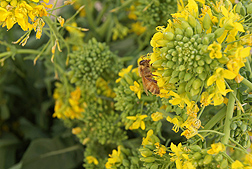By Jan Suszkiw
(USDA-ARS)

Photo by Gloria Degrandi-Hoffman.
Popular in Italy but also grown in the United States, rapini, or broccoli raab, is a turnip-like vegetable featured in the recipes of cable television’s top celebrity chefs. Foodies are not the only fans of rapini. Honey bees love it too, for its bright yellow, pollen-packed flowers. Studies by Agricultural Research Service (ARS) scientists show that managed honey bee colonies that foraged pollen from plots of fall-seeded rapini fared better than protein-supplemented colonies.
ARS scientists in Tucson, Arizona, began their studies in 2012 at the request of California’s almond industry. Almond growers rely on managed bee colonies to pollinate the state’s 800,000-acre nut crop, which starts flowering in February. Researchers investigated rapini because of its cold-hardiness, attractiveness to bees and ability to flower six weeks after planting—characteristics that could benefit overwintering bees.
During the fall, more than a million bee colonies are transported to California by beekeepers from throughout the United States. In the absence of natural food sources, the journey to spend the winter there can take a heavy toll on the bees, especially nurse bees and brood (young). The flow of nutrients through nurse bees affects colony size which, in turn, affects almond yields, explains Gloria DeGrandi-Hoffman, an entomologist who leads ARS’ Carl Hayden Bee Research Center in Tucson.
One way to tide the colonies over until bloom time in February is to feed them specially formulated protein supplements. However, in the study, the supplements didn’t meet all of the bees’ nutritional needs. The protein in the supplements also wasn’t well digested; about 65 percent was excreted as waste. With rapini pollen, only about 30 percent of the protein was lost, according to DeGrandi-Hoffman, whose team reported these and other findings in a recent 2015 issue of Apidologie.
Read more about rapini in the February 2016 issue of AgResearch.
ARS is USDA’s chief intramural scientific research agency.